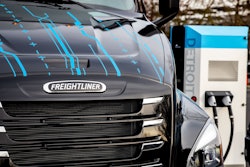Once technological progress picks up speed in a given lane, it can seem like its route to the future is inevitable and the endless adjustments needed to get there— and the dead ends backed out of – fade into a gentle blur.
To some degree, when it comes to the greening of heavy-duty diesel engines it already seems that way. The first emission standards for these engines became effective in California 1973 and across the nation a year later.
Over the past 50 years, those standards have been tightened again and again, forcing engine makers to advance technology rapidly and fleets to adapt to pluses and minuses of running the latest emissions-compliant engines.
As California keeps leading the way in shrinking greenhouse gas emission levels via rulemaking by the California Air Resources Board (CARB), motor carriers and other truck operators will see changes year by year in which engine models they can buy to operate in the Golden State and the other states that opt to mirror CARB rules.
A year of difference
Next year will be a bellwether in this regard. That’s because 2024 marks a sharp dividing line. While California and federal emission standards are usually more or less aligned, the latest CARB low NOx emission standards — effective in California starting in 2024 — are more stringent than U.S. Environmental Protection Agency (EPA) rules. (N.B. Per CARB, truck regulations are based on the model year of the engine. Generally, the model year of an engine is one year older than the vehicle model year. So, a 2023 truck is likely to have a 2022 engine model year.)
Specifically, CARB will be stricter on NOx next year as its rule matches up with EPA’s upcoming 2027 regulations for nitrogen oxide emissions. In addition, the agency will modify elements of its 2024 ultra-low NOx emission regulations for which manufacturers will provide offsets as necessary to maintain California’s emission targets.
A Daimler Trucks North America (DTNA) executive shed some light on how the CARB changes for 2024 will impact fleet purchasing decisions. During a panel discussion at the recent American Trucking Associations Management Conference and Exhibition in Austin, Texas, DTNA Vice President of Product Compliance & Regulatory Affairs Sean Waters said that tighter emission rules are impacting both the development cycle for OEMs and the decision-making of fleets.
Perhaps alluding to the reality that California is aiming to make all medium- and heavy-duty trucks run emissions-free by 2045, Waters remarked that “to be successful in zero emission trucks, we have to have product and you have to have a total cost of ownership. Electric trucks today are expensive. There's a lot of government incentives but certainly there is a lot of work to do to get the cost down."
Certainly with 20 plus years to when only electric trucks of some sort will be legal on California’s freeways and byways, fleets will keep on buying diesel engines and make specific purchase choices based on which states their trucks will be rolling through.
Choices to make
CCJ queried DTNA on how the CARB NOx changes for 2024 will affect its engine offerings in California. “Customers continue to have a choice of which engine in our heavy-duty engine platform-- or electric propulsion system -- works right for them,” a spokesperson said. “And we highly encourage all of our customers to work closely with their local dealer when spec’ing and ordering to ensure the right fit for the right application.”
According to DTNA, CARB has established “tough and challenging rules that rightfully afford manufacturers the flexibility to meet their regulatory requirements. For 2024, our pathway includes offering our customers in California the choice of DD5, DD8, DD13, DD16 and electric powertrain and it’s too early to say whether that pathway requires revision.”
Asked about what options California operators seeking maximum power with a big-bore engine will have, the spokesperson replied that “for customers with applications that require this kind of configuration and who desire an integrated powertrain, the DD16 is available for order in our products, as is the Cummins X15. Both are available in limited quantities for delivery in California.
“While the rules imposed by CARB are certainly challenging, the agency (rightfully) incorporated flexibility for OEMs on how those rules are met,” he continued. “For us and in California, we feel a focus on DD5, DD8, DD13, DD16 and electric powertrains provides our customers the right balance of propulsion choice for vast application coverage.”
Daimler Truck AG and Cummins in 2021 established a global strategic partnership for the development of medium-duty engines that will replace the Detroit DD8 and DD5 engines as available powerplants in North American trucks sometime in the second half of this decade.
The spokesperson added that DTNA looks forward to continuing to work with CARB on “smart, sensible rule-making that helps to reduce emissions and protect the environment while ensuring the resiliency and competitiveness of the medium- and heavy-duty commercial vehicle sector.”
Rumor sunk
Sea changes tend to roil the waters with rumors. Daimler Trucks is not the only engine manufacturer being impacted to one degree or another by CARB’s stiffer 2024 NOx rules. Recently, a rumor bubbled up in a blog post that suggested that Cummins starting next year will face restrictions on selling its popular X15 big- block engine in the state, due to the California Air Resources Board’s decision to limit NOx emissions to 0.02 beginning in 2024. This scuttlebutt further held that next year, Cummins will only be permitted to place a maximum of 800 of these engines in new trucks sold within California.
But Cummins Inc. dashed cold water on that talk. “Cummins and others in the industry have worked transparently with CARB to be able to provide solutions to the California market in 2024,” a spokesperson told CCJ. “These discussions resulted in various provisions that allow Cummins to provide our entire diesel portfolio at volumes that support the market demand. While Cummins will have restrictions on diesel product available specifically in California, the limits reported in the blog are not accurate.”













